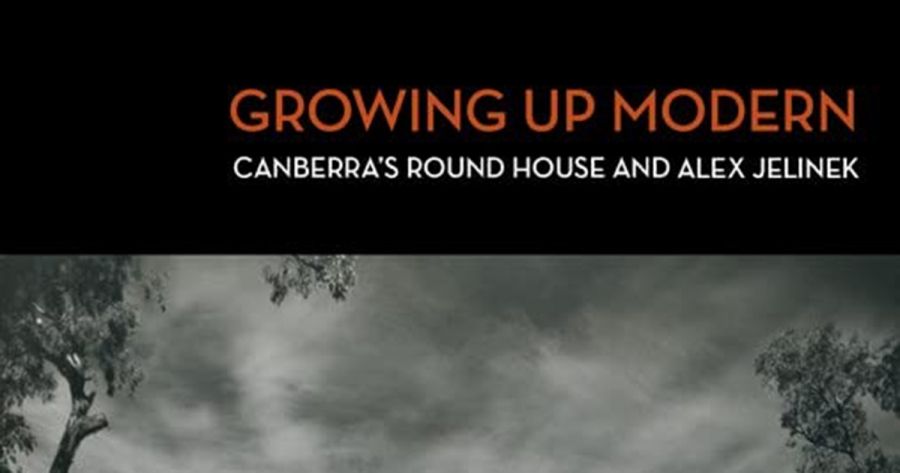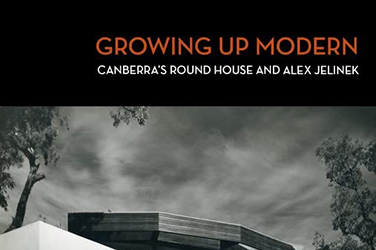
- Free Article: No
- Contents Category: Architecture
- Review Article: Yes
- Article Title: Curve as cue
- Article Subtitle: An absorbing multicultural story
- Online Only: No
- Custom Highlight Text:
Childhood memories often merge real life with imaginary nostalgia, but in Growing up Modern, Roger Benjamin’s memoir of his family’s 1956 modernist Round House, in the then rural Canberra suburb of Deakin, we find adolescent memories collaged with a mix of archival, architectural, social, and personal histories. It is set mainly during Australia’s postwar years of the 1950s when reconstructive policies drove economic, scientific, educational, and cultural reform. this was also a time when an influx of immigrants, multicultural labourers, and specialist émigrés inserted themselves into Australia’s Anglocentric landscape. The book tells a Canberra and Melbourne story about architectural and cultural modernism, so often imported with the émigrés, that countered Australia’s cultural cringe and anachronistic nationalism.
- Article Hero Image (920px wide):

- Article Hero Image Caption: Krimper/Jelinek dining suite with fountain and Chinese landscape scroll, 1957 (photograph by Wolfgang Sievers, reproduced courtesy of Roger Benjamin)
- Featured Image (400px * 250px):

- Alt Tag (Featured Image): Sheridan Palmer review 'Growing up Modern: Canberra’s Round House and Alex Jelinek' by Roger Benjamin
- Book 1 Title: Growing Up Modern
- Book 1 Subtitle: Canberra’s Round House and Alex Jelinek
- Book 1 Biblio: Halstead Press, $49.95 pb, 196 pp
- Book 1 Cover Small (400 x 600):

- Book 1 Cover (800 x 1200):

Benjamin structures his architectural history-cum-memoir around his parents Bruce and Audrey Benjamin, ‘left-leaning social progressives’ who relocated to Canberra via Oxford from Melbourne’s élite Jewish and business echelons. They were introduced to Jelinek by Bruce’s cousin, the modernist artist Lina Bryans, described by Alan Sumner as the ‘Gertrude Stein of Melbourne’. Bruce Benjamin was a collector of art and cars, and it is through the ‘guiding spirits’ of treasured art works and iconic vehicles that the design of the house is shaped. A central, cylindrical glass fountain served as a point from which curved walls took their cue, with one wall showing off a Ming scroll in its five-metre entirety. The fountain was a receptacle for rainwater from the butterfly roof; as Jelinek said, ‘Rain coming down the glass cylinder is visible from the dining room and lounge-room, and gives the same visually cooling effect of water running down the inside of a butcher shop window.’ One might muse on Roy Grounds’s large water window for the St Kilda Road National Gallery of Victoria, and whether it owes something to Jelinek’s Round House. The use of water in the design of the house may have originated from Jelinek’s employment on the Snowy Hydro Scheme where, as a newly arrived émigré, he was acutely aware of the sustaining force of water in the Australian landscape’s hostile climate: ‘Rainwater and sunlight are the most important gifts of nature … in this house I have tried to capture their movement and beauty, and make them part of the life of the house and the family.’
Lina Bryans played something of a matchmaker between Jelinek and Bruce Benjamin, as well as introducing Bruce to Ian Fairweather’s paintings, eight of which adorned the Round House. The art historian Bernard Smith believed that 'Australia assisted Fairweather to achieve the best that was in him’, but Bryans’s support of this reclusive artist was crucial to that end. We find in this book Wolfgang Sievers’ brilliant photographs of various stages of the construction and completion of the house, his stark lines of design and professionalism attesting to what this German émigré brought to Australia with his documentation of architectural modernism and multinational industries. Another émigré, the Romanian furniture maker Schulim Krimper, who had been active in the Deutsche Werkbund until exiled by Hitler, was commissioned to make no less than eighteen pieces of outstanding furniture for the Round House.
Benjamin’s meticulous audit of his family’s life includes everyday household objects, recipes, the genus and botanical names of trees and shrubs planted, names of manufacturers of sundry items, favourite pop music, colours of floors and fabrics. While this sounds tediously obsessive, his attention to the detail of mid-century culture and design, through to the radical 1960s cool bohemianism, and alterations and additions made to the house up to the present, provides a historical exactitude and a commanding encyclopedic homage to this extraordinary dwelling. Nor does Benjamin shy away from births, deaths, marriages, and tragedies, each handled calmly while evocatively permitting characters to exit with dignity.
We are introduced to the British maverick art historian and critic Donald Brook and his wife, Phyllis, who lived for a time in the rear garden flat and became, as Brook describes, ‘a sort of locus parentis’ after Bruce Benjamin’s death in 1962. And while Jelinek’s brief and brilliant architectural career petered out in the early1960s because of his reluctance to compromise with clients, this inventive European quietly maintained a creative life with and beyond Bryans, until his death in 2007.
There are many undervalued contributors to Australia’s road to modernism, this generously illustrated book recognises some of the exemplary artisans whose inspired idealism matched Alex Jelinek’s magnificent Round House.


Comments powered by CComment